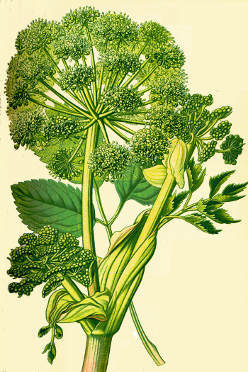|
Angelica is mentioned as protective against evil forces as far back as the Icelandic sagas. In European practice, powdered angelica was sprinkled around the house to repel witchcraft. In Hoodoo, angelica root is protective of hearth and home and may be an ingredient in a mojo bag for that purpose. Together with salt, it is used as a powder for purifying the house. It is also combined with salt and sulfur to become a component in uncrossing powders. A woman who has been the target of a violent man can carry an angelica root dressed with Fiery Wall of Protection oil. Top Dried leaves have been added to magical smokes for astral work. Some make a flower essence from angelica for working with angels. It has been considered linked with angels (especially the Fire angel, Michael) since the 1600s, when people believed that it protected against plague (and it would protect from fleas due to the smell, but the sap of the fresh plant can irritate the skin of sensitive people). Anything that protects from plague can be used to protect against plaguey spirits. Dried leaves and stems make a nice pot pourri ingredient, and dried seeds are good for incense. It also has often been incorporated into a lucky charm, thus showing another perspective of Venus and its typical connection to money. Top In Herbalism In European herbal medicine, angelica is warming and gently stimulating. Historically, its seeds have been an ingredient in medieval medicinal liqueurs like Chartreuse and Benedictine, and a fresh stalk can flavor white wine. It relaxes smooth muscles and is anti-spasmodic. It's cleansing, being anti-fungal and anti-bacterial. It induces healthy sweating when a person has a cold. Its Venus medicinal properties are strictly of the Maiden aspect: it has historically been used to bring on menstruation but is recommended against use in pregnancy. Since it raises blood sugar, angelica should not be used by folks with diabetes. Top Culinary and Other Uses This was a Viking vegetable and is still one of the few veggies available to people of the far north, like Laplanders, Eskimo, and folks of the Faroe Islands (WAY the heck up there--good thing it's warming!). Many northern folks also smoked the dried root or flavored fish with the leaves. Angelica stalks are sometimes combined with rhubarb in the proportions of 1 part angelica to 4 parts rhubarb to make pie fillings (the angelica helps counter rhubarb's sourness). Angelica digestive bitters are decocted of 2 parts dried angelica leaves, 2 part dried holy thistle, 1 part hops. Check out the candied angelica recipe. Top How to Grow Angelica Angelica germinates in 30 days, but germination is increased by cold stratification. Transplant out in spring or fall or direct sow in full sun or partial shade. Angelica likes rich, moist soil in partial shade, such as it would find naturally in a dappled woodland. Plant gets 72-96"/1.8-2.4m tall--it's a big one! Space 12-24"/45-60cm apart. Perennial to zone 4 (-30F/-34C). Some people get a skin irritation from handling the sap of this plant. Bees and butterflies enjoy the flowers. Usually takes three years to flower. Breaking off the flower heads so it doesn't go to seed will make the plant live longer, but allowing the plant to reseed will mean you get plenty of baby angelicas the following year. Roots can be harvested in the late fall of the first year. Dehydrate on the lowest setting of your dehydrator. If the root is thick, cut it up so it doesn't mold. General growing info Top |
Angelica archanglica
We have wild angelica as well \Uses in Witchcraft & Magic:
Protection © 2010-2024 Alchemy Works. No reproduction of
any part without permission. |
|
In April or May, prior to the feast of St. Michael the Archangel, a patron of this plant, cut large angelica stalks in their second year while they are still green rather than purple or white. Strip off the leaves and cut into pieces as long as your palm. Boil some water and put the stalks in to blanch for 2-6 minutes. Some add half a teaspoon of baking soda per gallon of water to maintain the green color and to soften the stems somewhat; others don't. Drain in cold water, rinse, and drain again, then peel off the long stringy bit, as you would do with celery when making celery soup. Make a simple syrup (1 part water and 1 part sugar, heat until it is clear) and soak the stalks in it for 24 hours; you can put a dish on top of the stalks to hold them below the surface of the syrup. Some put a layer of grape vine leaves on the top of the syrup to increase the crispiness of the stalks, just as in pickling. Fish the stalks out and boil the syrup until it starts to thicken, then pour over the stalks and let sit for a day. Repeat this straining, boiling, and letting sit for three days. On the fourth day, boil the syrup to 245F and then put the angelica stalks in the pot. Bring back to a boil. Repeat until the stalks start to look translucent but before they get limp. Let cool and then drain the stalks and let them dry on a rack. When they are dry, dust with fine sugar and dry in a slow oven, around 170F. Keeps in jars for four months to two years. Top |
|
Alchemy Works products are offered for use in spiritual, ritual, meditative, and magical practices, not for medicinal or cosmetic purposes. The information on this website is provided for its folkloric, historic, and magical value. It is not intended to be a substitute for professional medical advice, diagnosis, or treatment.
 Angelica archangelica
Angelica archangelica